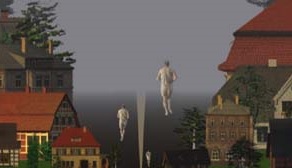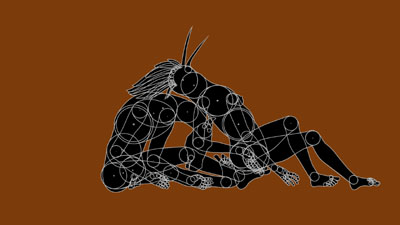Invited Writers
This new section on the AICAHK website supports young Hong Kong writers. The latest articles by invited writers are below. Other articles by invited writers can be read by clicking on the 'Archive' year and month on the side-bar.
現實中的虛幻: Tamas Waliczky帶我從古埃及到他的威尼斯雙年展 | Life as ‘ignis fatuus’: The Voyage with Tamas Waliczky from Ancient Egypt to the Venice Biennial
Jess Ching Wa LAU
at 2:46pm on 21st October 2020



Captions:
1."THE WAY", 1994, Images copyright © 1994 Tamás Waliczky
2. "LANDSCAPE", 1997, Images copyright © 1997 Tamás Waliczky
3. "MARIONETTES", 2006, Images copyright © 2006, Tamás Waliczky
(Please scroll down for English version)
一幅古埃及壁畫投影於課室螢幕,我們和教授一起看,發現畫中人物的眼睛和上半身都以正面描繪,腹部以下至雙腳卻是側面,整個畫面以多重視角結合。然後教授問:「這幅畫在描繪現實嗎?你記憶中的眼睛或手和腳長怎麼樣?」到底何謂現實?記憶中的現實、經驗累積的現實、把眼睛打開後那所謂眼前的現實?旁邊的同學比我高一截,誰看到的又會更貼近現實?人們會否把自己想像中的美好當作現實?當現實本身搖擺不定,人該如何觀看世界?我當時二十歲,事隔至今接近十年;依然清楚記得那天,還有腦袋一瞬間被打開的感覺。
2011年到2014年我在香港城市大學創意媒體學系修讀數碼影像,「Animation 1」為第一學年的必修科。當時我坐在冷得像雪藏庫的CMC(創意媒體中心)七樓電腦房:沒有一扇窗、數十部黑色電腦幾行排開、每台配有超薄液晶屏幕。相比中學的小班房、木枱和椅子,身處其中不禁有種「果然係唸媒體藝術。」的感覺。坐在課室第一排,Tamas Waliczky教授站在我前方,鴨咀帽子、格仔襯衣,正當我們期待他會教導什麼高科技動畫原理,他竟然在螢幕放上一幅古埃及壁畫。
Tamas Waliczky生於匈牙利布達佩斯,九歲開始創作動畫,1983年始鑽研以電腦創作,1989年已獲奧地利國際電子藝術節金獎。十年前,他加入母校創意媒體學院,2019年更代表匈牙利參展威尼斯雙年展。今年教授決定退下教職,重回歐洲發展。從學生時代至今,Tamas一直支持和鼓勵我繼續做藝術,但這些年關於他的中文報導不多,我問准許可,敲下這篇文章作為多年來的答謝,和師生回憶的筆記。
對Tamas的課堂印象依然深刻,如他指導抽象動畫,會先從抽象畫的歷史講起。與其使用主流動畫界的軟件工具,他選擇教導我們用一個完全免費及開源(Open source)的 3D繪圖軟件Blender。那時候好些同學都很生氣,覺得「出嚟做嘢都冇人用,學嚟做咩?」教授卻認為,開源軟件和共享資訊庫其實相當適合個人工作者或藝術家。當世上那麼多人不計成本,將自己的研究及創作成果放到網上分享,為的不過是令大家可以更自由自在地創作。
「如果有兩條路:左邊的是大家都在而相當熱鬧,但你根本不享受;你也只能走右邊那條,儘管只有你一人」這段話我從Tamas那邊聽過不止一次。回到1983年,在電腦流行普及以前,他為了鑽研用電腦做動畫,辭掉了手繪動畫工作室的高薪厚職,當時的同伴都笑他是瘋子。這個瘋子就一直做他相信的作品直到現在,甚至在去年代表國家匈牙利出展「意大利威尼斯雙年展」,也是歷年來雙年展為數不多的媒體藝術家。
媒體藝術或3D實驗動畫總帶有艱澀和冷冰的刻板印象。Tamas的作品即便具有相當實驗性與技術性,卻依然能展現人的溫度,為觀者創造出各個截然不同的新世界。1994年的作品〈The Way〉,是個顛倒了常用的單點透視系統的動畫作品:畫面中心幾個人在跑步,離觀者愈近的屋子和樹會變得愈小,反之離觀者愈遠則會愈大。1997年作品〈The Landscape〉,詩意地把動畫中的時間凍結,唯一有生命力的是動畫中的攝錄機,它的移動讓觀者發現該世界的時間是靜止的。2007年的〈Marionettes〉,他在三維世界裡創造了一系列扯線木偶,然後他去掉自己動畫師的身分,沒有將它們animate(使其動化),因而觀眾所見那木偶不斷倒下的「動畫」,其實來自動畫世界中的自然力量*2(質量、重力、碰撞與隨機)。
我的畢業作品《消失之中》打從概念開始,就花了相當長時間與Tamas(還有余家豪老師和黎肖嫻教授的指導)討論和思考───如何用動畫做藝術、動畫能否記實、還有其作為媒體的特質等等,至今仍在影響我創作。而《消失之中》最終演變成一個關於物質如何在影像中轉換、思考動畫師的角色是什麼、並將勞動過程打開的小小影像實驗。學期尾, 同學們都要展示自己的作品概念,很快發現我的動畫將會是當年唯一一個去掉故事和角色設定的作品。記得當天有導師質疑我做的並非動畫:他看不到動畫的12項基本法則 (註1)。又有同學說:「咁都得?係咪唔識Animate咋。」下課後我在走廊遇到Tamas,他安慰我過後突然說:”You can only grow stronger, if you really want to make art.” 後來我花了半年時間,用力將作品完成,也在往後幾年陸續得到展出機會,讓本來沒打算成為藝術家的我,仍能繼續創作。在此特別感謝Tamas當年給予的提醒。
2019年的威尼斯藝術雙年展,他展出以「幻想攝影機」為題的作品,透過三維電腦圖像與動畫創造了一系列不符合「標準」的「虛構相機」。人如何觀察世界直接影響了攝影機的構造,而機械發展亦對人的想像構成重大改變。Tamas創造了曝光時間與方式、光圈、快門及鏡頭結構都重新設計的「虛構相機」,更有趣和令人佩服的是這些相機都不是憑空想像,而是有根有據、皆能被實際生產出來。作品反覆打開觀者的視覺感知,展示捕捉,描繪現實與影像成像(image-making)的各種可能。我突然想起當年「Animation1」的第一課,或在更早的時間點開始,Tamas就一直在追問何謂現實,以及人到底可以如何觀看世界。他沒有停止思考,即使在這條算不上熱鬧的藝術路上,還是踏踏實實地繼續創作。
後記:因為要寫這篇文章,我聯絡了同為Tamas學生,剛於愛莎尼亞念畢動畫碩士的校友Aggie。這通跨越了半個地球的電話,長達一個多小時。原本公務式地拜托對方分享一些關於教授的故事,好讓文章更立體,最後我倆竟然都說到要擦眼淚。Tamas曾經對她說過一個維尼熊的故事,在森林前,維尼跟豬仔說:「一起去探險吧!」豬仔非常擔心:「如果下雨怎麼辦?」維尼說:「如果不下雨呢?」
註1: 動畫的12項基本法則(The Twelve Basic Principles of Animation)源自於《The Illusion of Life: Disney Animation》一書。
Tamas Waliczky 網站:www.waliczky.net
英文翻譯:曾凱渝
Life as ‘ignis fatuus’: The Voyage with Tamas Waliczky from ancient Egypt to the Venice Biennial
Jess LAU Ching-wa
An enthusiastic discussion began when an ancient Egyptian mural was projected onto the screen. The characters in it were drawn with a front-view upper body and side-view lower body, creating a multi-view picture. “Is the painting depicting reality? What are the forms of the eyes, arms or legs in your memory?” Professor Tamas Waliczky (Tamas) asked. Questions then raced through my mind: What is reality? Is it in memory / in the accumulated experiences / in what we see with our open eyes? Who is closer to reality - the taller classmate by my side or me? Would fantasies be confused with reality? How would we observe reality in an ever-changing world? Ten years have gone by, but I still remember my 20-year-old self, sitting mouth-opened in front of the mural, as if it were just yesterday.
‘Animation 1’ was the first-year compulsory course during my studies in Digital Imaging at the School of Creative Media, City University of Hong Kong (2011-2014). The moment I first stepped into the freezing classroom of the Creative Media Centre (CMC), I was surrounded by walls, rows of computers and LED screens, but not a single window. Sitting shivering in the first row, I couldn’t help but wonder at the modernity of media art studies. The lesson began; we prepared ourselves to be engulfed by high-tech animation principles. Tamas, however, gave us a punch: he walked in wearing a baseball cap and check-shirt, switched on the computer, and projected an ancient Egyptian mural.
Born in Budapest, Tamas Waliczky began his odyssey in animation at 9 years old. Just six years after his initial attempt working with computers, he won the First Prize (Golden Nica) in the Computer Graphic Category of Prix Ars Electronica, Linz in 1989. Since 2010, Tamas has been teaching in the School of Creative Media for ten years, and last year in 2019, he represented Hungary at the 58th Venice Biennale. Returning from Italy, he did not stay long in Hong Kong this time, but has embarked permanently to Europe on his next chapter of creation. On the path of learning and creation, Tamas has always been a warm support, guiding and encouraging me. Before waving goodbye to my beloved teacher, I have written this piece as a farewell gift - genuinely composed, rendered with flashing frames of our teacher-student reminiscences.
From the very first slide frame, Tamas’s lectures left a deep impression on me. He would start off an abstract-animation lesson with the history of abstract painting, choosing to teach us on a free, open source 3-D creation suite named Blender, which ignited the ire of a few students who considered the software impractical for future employment. Tamas, on the other hand, believed that open source software and shared databases are, on the contrary, a fertile field for artists and freelancers. Regardless of cost, countless people are cultivating the soil of creativity, innovation and freedom by sharing the results of their research and creation online.
“When two roads diverge, on the left there are lots of people, but you do not enjoy it; you can only take the other, even if you are on your own,” the second slide frame was projected with these words from Tamas: more than once I have heard him say this. Travelling back in time to 1983 when computers had not yet overtaken the world, Tamas quit his highly paid job in a hand-drawn animation studio, in exchange for his all day-and-night exploration of the universe of computer animation. His friends called him crazy, but this ‘crazy’ man has continued his animation adventures to become one of the few media artists who have represented their country at the Venice Biennale.
Despite the obscure and distant stereotype of media art and 3-D experimental animation, Tamas always delivered the warmth of nature and mankind through his experimental works by creating a unique world for the audience. In his work The Way (1994), Tamas has inverted the usual perspective system commonly used in animation. As a result, the closer an object is from view, the smaller it appears; while further away, the larger an object becomes. The audience would find the farthest runner the biggest in his animation showing three runners. In The Landscape (1997), by poetically freezing time, the audience can glimpse some incredible moments in a small German village, with the camera being the only living element that moves through the landscape. In Marionettes (2007), Tamas has eliminated his role as animator from the animation. The marionettes, with no strings attached, collapse by natural forces - mass, gravity, collision and randomization. Replacing strings, movement is calculated by physical simulation algorithms: nobody animates the body but natural forces.
During the process of making my graduation work, The Fading Piece, Tamas (also my teacher Mr Ka Ho Albert Yu and Prof. Linda Lai Chiu Han) and I continuously discussed back and forth: what is animation in art / what if an animation is documentative / what makes this medium special? These conversations still today profoundly affect my work and thinking. After all, The Fading Piece turned out as an experiment on the transformation of different substances in moving images, the position of an animator as well as the revelation of time. At the end of the semester, when all of the graduating students were presenting their work and concepts, I realized that my work was the only animation with no storyline and characters. Without encompassing the 12 basic principles of animation^, a professor questioned if my work could still be called an animation, and some other students doubted if I could actually do animation. After the lecture, I came across Tamas in the corridor, “You can only grow stronger, if you really want to make art!” What he said hit my heart. It eventually took me six months to finish the work, and I am grateful for different exhibition opportunities after graduation. I wish to express my deepest gratitude to Tamas, whose advice has supported me along my journey to being an artist; an ambition I had never previously considered.
At the 58th Venice Biennale (2019), Tamas exhibited his work, Imaginary Cameras, which comprises a series of images of unique, exceptional, and fictional cameras created through 3-D computer graphics and animation. The development of cameras is entwined with people’s perception of the world; in the meantime, the evolution of machinery often transform people’s imagination. Although fictional, what makes the redesigning of the aperture and shutter, duration and ways of exposure, and the structure of the lens most remarkable is that they could in fact be actualized and produced. Imaginary Cameras is thought-provoking, it repeatedly opens the audience''s visual senses, and concurrently shows diverse possibilities in image-making and reality-mapping. From time to time, Tamas asks ‘what is reality?’ and ‘what are the different ways of seeing the world?’, just as he did when I first met him in the ‘Animation 1’ lectures. On the road, mostly alone, being strong and continuously thinking, he creates.
P.S.: Recently, I contacted Aggie, a former student of Tamas who has just graduated with a Master of Animation degree in Estonia; and, hoped to hear more stories about our teacher. Surprisingly, we talked for more than an hour, and ended the call in tears. Sniffing her running nose, Aggie told a story shared by Tamas:
In the woods, Winnie-the-Pooh invites Piglet, “Let’s go on an adventure!”
“What if it rains?”, Piglet worried.
“What if not?”
Footnotes:
* Ignis Fatuus: a deceptive goal or hope; a light sometimes appearing in the night over marshy ground, often attributed to the combustion of gas from decomposed organic matter.
^ The Twelve Basic Principles of Animation originated in The Illusion of Life: Disney Animation.
Tamas Waliczky website: www.waliczky.net
English translation: Tsang Hoi-yu
|
|
|
|
|
|
